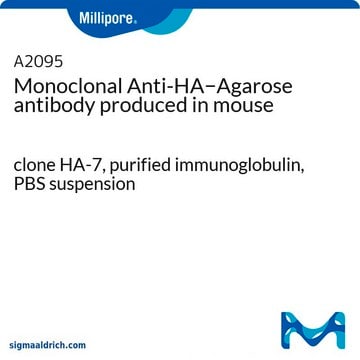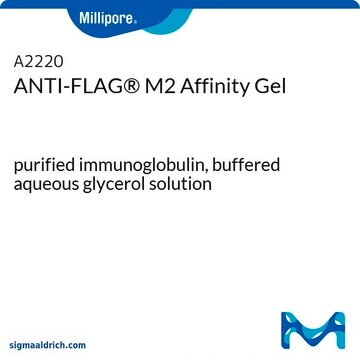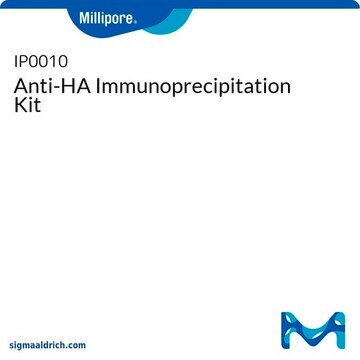This product does not have a specification that describes "mg of beads per one milliliter." The product is described as a "~ 4 mg/mL protein-to-beads ratio" meaning there is approximately 4 mg of antibody conjugated to 1 mL of beads. This is a description of the product and not a recommendation for use. The general guidance provided in the technical bulletin suggests using 20 µL of the anti-HA magnetic agarose beads, which have an estimated bead capacity of 50 µg. It is suggested to add a sufficient amount of cell lysate where 50 µg of the HA-tagged protein is expected to be present.
SAE0197
Anti-HA Magnetic Beads
Magnetic agarose, suspension
Synonym(s):
HA beads
About This Item
Recommended Products
General description
Application
Features and Benefits
- Antibody is conjugated to cyanogen bromide-activated magnetic agarose beads.
- Protein-to-beads ratio ~ 4 mg/mL.
- High specificity binding to HA-tagged proteins.
Other Notes
Storage Class Code
12 - Non Combustible Liquids
WGK
WGK 3
Choose from one of the most recent versions:
Certificates of Analysis (COA)
Don't see the Right Version?
If you require a particular version, you can look up a specific certificate by the Lot or Batch number.
Already Own This Product?
Find documentation for the products that you have recently purchased in the Document Library.
-
The beads are supplied as the suspension and the loading is described as 4mg of antibody for 1mg of beads. However the concentration of suspension is not specified. How many mg of beads are there in the 1ml of supplied suspension?
1 answer-
Helpful?
-
-
What is the average size of the beads?
1 answer-
This product consists of a non-crosslinked magnetic agarose resin with a bead size of 20-75 µm.
Helpful?
-
-
Is the antibody covalently conjugated to the beads and will the HA-antibody comes off during elution or boiling?
1 answer-
In SAE0197, the antibody is covalently conjugated to the beads, and the HA-antibody remains bonded to the beads during elution or boiling.
Helpful?
-
Active Filters
Our team of scientists has experience in all areas of research including Life Science, Material Science, Chemical Synthesis, Chromatography, Analytical and many others.
Contact Technical Service








